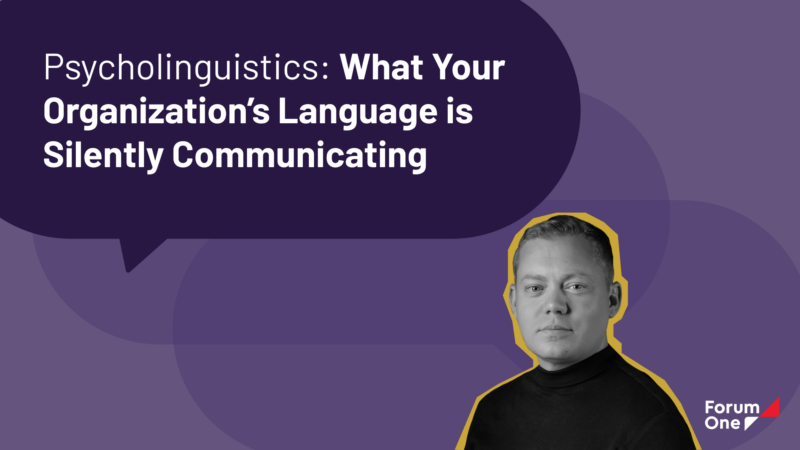Blog Insights
How to Use Psycholinguistics to Communicate Effectively

Language shapes brand perception and builds—or erodes—credibility and trust. With new tools and research—including a forthcoming report from Forum One—nonprofits and government agencies can learn to employ strategies already used in the commercial sector to communicate their mission, goals, accomplishments, and brand more effectively.
In my most recent webinar, I explored how the language that mission-driven organizations choose affects their relationships with current and future advocates. To understand how we are using language, we need to understand psycholinguistics.
What is psycholinguistics?
Psycholinguistics is a technical-sounding word but not a new practice. It combines methods and theories of psychology and linguistics to derive a fuller understanding of how the brain processes language. The advent of neuroimaging has made it possible to examine brain activity—what areas of the brain and neurons are firing—when a person is processing language. Mapping this research to huge data sets and creating validated algorithms makes it possible to “score” language in a consistent manner.
As a simplified example, we can think about scoring a nonprofit’s “About Us” page and revealing how well the words used there convey certain attributes. Perhaps authority, trust, and vision are core to this organization’s self-perception and the brand they’ve established. Analysis with a psycholinguistic lens can reveal if those attributes are supported or undermined by the language used on the page.
Why use psycholinguistics?
First, the commercial space is already using these tools. From Noom to the New York Times to Raytheon, marketers are applying lessons from psycholinguistics to capture audience interest and build brands, in the same marketplace for attention that mission-driven organizations compete in. While some of the largest charitable organizations may be using these tools, at Forum One we want to make sure that the widest swath of organizations can benefit.
Secondly, we live in an era of eroding trust. Research by the nonprofit and nonpartisan Pew Research Center last year found deepening erosion in trust in government and growing skepticism of science. Alarmingly, nearly half (45%) of Americans say colleges, universities, and K-12 public schools are having a negative impact on the country.
In this climate, sharing researched and impact-driven programs and advocacy may not be enough to effectively earn support. We know mission-driven communicators already labor over word choice. Psycholinguistics tools don’t replace their expertise but simply offer new strategies to boost effective communications.
New research sets a baseline and strategies for applying psycholinguistics
Forum One invested in a research project to analyze over 20 million words recently communicated by 20 nonprofit organizations and 13 government agencies on their own websites, emails, and social media accounts. The forthcoming report based on this dataset, Psycholinguistics: An Examination of Nonprofit and Government Communications, shares findings for the sector overall, and finds distinctions and comparisons that mission-driven organizations can use to boost their own language use and apply psycholinguistics going forward.
Watch the webinar for a full overview of these findings, and to explore how you can start to consider psycholinguistics in your work. A few areas we’re already seeing applications with Forum One partners include:
- Diversity, Equity, and Inclusion: Psycholinguistics tools can track the use of pronouns to ensure organizations aren’t expressing a gender bias and are welcoming to all
- Differentiation: Psycholinguistics allows objective measurement of peers to identify opportunities to stand out, making you more memorable and less commoditized
- Management: To understand employee feelings about company culture and wellbeing
- Grantmaking: Psycholinguistics can be used to remove bias in decision-making and to predict success
Ready to learn more? Watch for the full report, coming soon, and reach out anytime to discuss how these tools can apply in your work.
